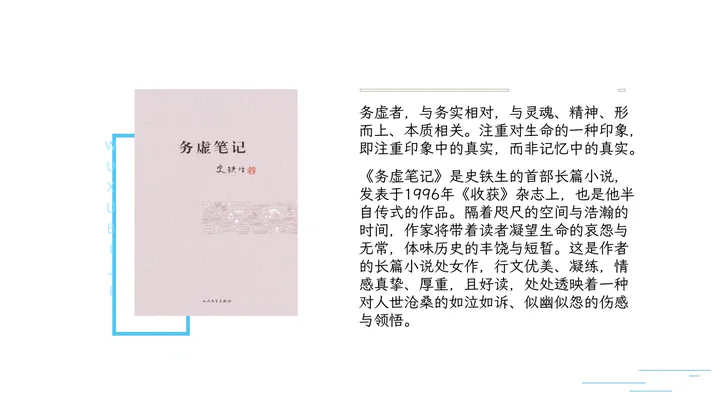务虚笔记 - The Pursuit of Nothingness
 If you can read Chinese, here is one [good introduction] (https://www.cnblogs.com/noaL02d/p/-/report_wuxubiji) to the text.
If you can read Chinese, here is one [good introduction] (https://www.cnblogs.com/noaL02d/p/-/report_wuxubiji) to the text.The Pursuit of Nothingness is one of the most profound literary meditations on existence, resilience, and the search for meaning in modern literature. This is true not only within the context of Chinese literature but also in world literature at large. Written by a man who faced immense physical challenges himself, this work is largely autobiographical in its intimate reflections. Yet nowhere have these reflections felt more universal, offering insights that feel more urgent than ever in our age of uncertainty and rapid change.
Now available in English for the first time, The Pursuit of Nothingness invites a new audience into its quiet yet powerful explorations of fate, suffering, creativity, and the fragile beauty of being alive.
You can read the book if you scroll to the end of this post (fullscreen mode available). But as a translator, let me explain how I come to this particular title.
虚 vs 实
In Chinese, 务实 (wùshí) means “pragmatic” or “focused on concrete realities,” suggesting an emphasis on practical, tangible results. It relates to the idea of being grounded in reality, dealing with facts, and pursuing goals that yield substantial outcomes. In a sense, it is what we now often call “result-oriented” (as if this is the best thing in the world!)
务虚 (wùxū) is the opposite, and can be translated literally as “focused on intangibles”. The intangible in Chinese has a slightly negative connotation. If we say someone is 玩虚的, this translates to “he is playing tricks, or all words but no deeds”.
This is obviously not how our author use the word. To my understanding, when Shi uses the word 虚 against the background of 实, he is referring to a pursue of meaning independent of our concrete realities. It is Meaning with a capital M. And here lies the idea embodied by another distinguishing feature of the novel: all the characters are represented by a letter. It is a gesture of abstraction, of virtualizing identities.
Here is a list of major characters:
| C: man with disability (the author) X: C’s lover | Z: painter WR: politician O: teacher | F: Doctor N: Filmmaker | HJ: runner, restaurant owner T: HJ’s love | L: poet | sans nom: Z’s uncle Z’s parents T’s parents ? woman in the sunflower meadow |
|---|
What is left stripping away individual identities such as names? The essence.
This essence is not the same as in Sartre, where nothingness is set up against the essence, as an absence of essence. It is rather a cosmic intention. In Pursuit essence refers to the idea of beginning, of origin, the idea of finding one’s way back to the origin of human nature.
Void, Nothingness, Emptiness
28 我曾相信历史是不存在的,一切所谓历史都不过是 现在对过去(后人对前人)的猜度,根据的是我们自己的处境。我 不 打 算 放 弃 这 种 理 解 , 我 是 想 把 另 一 种 理 解 调 和 进 来 :历 史 又 是 存 在的,如果我们生来就被规定了一种处境,如果你从虚无中醒来 (无以计量的虚无)看见自己已被安置在一团纵纵横横编就的网 中,你被编织在 一个既定的网结上(看不出条条脉络的由来和去 处,这是上帝即兴的编织),那就证明历史确凿存在、这两种针锋 相对的理解互相不需要推翻。 29 那无以计量的虚无结束于什么?结束于“我” 我 醒 来 ,我 睁 开 眼 睛 ,虚 无 顷 刻 消 散 , 我 看 见 世 界 。 虚无从世界为我准备的那个网结上开始消散,世界从虚无由 之消散的那个网结上开始拓展,拓展出我的盼望,或者随着我的盼 望拓展…… 43 我从虚无中出生,同时世界从虚无中显现。我分分秒秒地长大,世界分分秒秒地拓展。是我成长着的感觉和理性镶嵌进扩展着的世界之中呢?还是扩展着的世界搅拌在我成长着的感觉和理性之中?反正都一样,相依为命。
Because we obviously cannot translate it into The Pursuit of Essence, I look for other terms that are literally closer to 虚 but carries a philosophical connotation that the author wanted it: void, nothingness, emptiness.
- Void: In Paradise Lost by John Milton, the void is depicted as the vast, empty chaos between Heaven and Hell, where Satan travels after his fall. The void is described as a place of disorder, lacking form but holding the potential for creation or destruction.
Example:
“A dark illimitable ocean, without bound,
Without dimension, where length, breadth, and height,
And time and place are lost.”
I like that the “void” as depicted by Milton convey a sense of the origin, which is similar to how Shi describes as “waking up from the void”.
- Nothingness
But the book itself is very meaning searching and philosophical. It does resonate with Jean-Paul Sartre’s famous Being and Nothingness (L’Être et le néant : Essai d’ontologie phénoménologique).
The word néant really carries with it a lot of things. Although from different roots, it feels close to née, which is nascent, being born. The ending also suggests a sense of becoming, so néant reminds us of devenant, naissant.
In other words, nothingness is an established convention that I think works really well (if you understand this convention). This is why I chose to use the term.
“Nothingness lies coiled in the heart of being — like a worm.” “The being by whom nothingness comes into the world must be his own nothingness.”
- Emptiness: this is a more neutral term than “void” or “nothingness,” often used to describe a lack or absence without the weighty connotations of existential dread or the cosmic scale. It’s common in Buddhist philosophy, where emptiness refers to the idea that things have no inherent, fixed essence.
In The Heart Sutra of Mahayana Buddhism, emptiness is a core concept:
“Form is emptiness; emptiness is form.”
Here, emptiness doesn’t mean literal nothingness but rather the absence of fixed, inherent essence in all things.
Surprisingly, Shi doesn’t seem to be interested in Buddhism and so far as I can tell, there is no reference to Buddhism in the book. Therefore, I will not choose this term.
Here are some more passages from the book where the term is being used. See if you agree that nothingness is the best word to characterize the meaning.